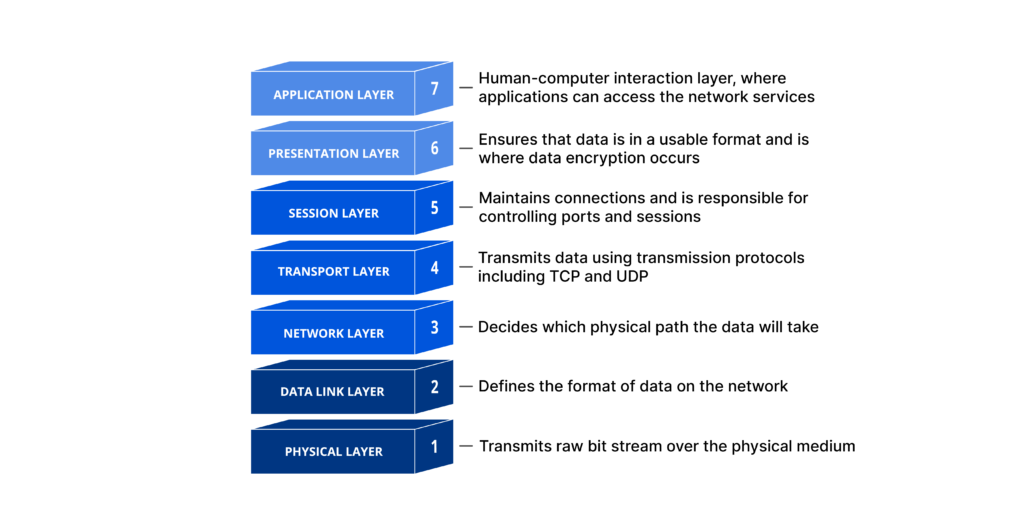What is the OSI model?
The OSI model (Open Systems Interconnection model) is a conceptual framework for understanding and designing computer network protocols. It was developed by the International Organization for Standardization (ISO) in 1984 and has since become a widely accepted model for understanding network communication. It is based on the concept of splitting up a Communication system into seven abstract layers, each one stacked upon the Last.
The OSI model is used as a conceptual framework for designing and understanding computer network protocols. It provides a standardized way to describe the different layers and functions of a communication system, and it helps to ensure that different network components can communicate with each other in a reliable and efficient way.

The OSI model is organized into seven layers, with each layer representing a specific aspect of network communication. These layers are:
- Physical layer
- Data link layer
- Network layer
- Transport layer
- Session layer
- Presentation layer
- Application layer
Each layer has its own set of protocols and functions, which work together to ensure that data is transmitted between devices in a reliable and efficient manner. The OSI model provides a standardized way for different devices and network components to communicate with each other, regardless of the underlying technology or hardware.
Here are the seven layers of the OSI Model
1. Physical layer:
The Physical layer is the lowest layer in the OSI model, and it is responsible for the physical transmission of data between devices on a network. This layer deals with the actual hardware components and physical aspects of network communication.

Here are some key features of the Physical layer:
Hardware: The Physical layer deals with the actual hardware components of the network, such as cables, connectors, and network interface cards (NICs).
Transmission: This layer is responsible for transmitting raw data bits between devices on the network. It defines the physical characteristics of the transmission medium, such as the voltage levels, timing, and physical characteristics of the cables.
Encoding: The Physical layer also defines how data is encoded into a digital signal that can be transmitted over the network. This includes details such as the number of bits per symbol and the modulation scheme used to encode the data.
Error Detection: The Physical layer provides basic error detection mechanisms to detect errors that may occur during transmission, such as noise or signal attenuation.
Physical Addressing: The Physical layer defines how devices are physically addressed on the network, using a unique Media Access Control (MAC) address for each device.
2. Data link layer:
The Data Link layer is the second layer in the OSI model, and it is responsible for providing reliable data transfer between adjacent network nodes. This layer deals with the logical organization of data bits into frames, as well as the control of data flow and error detection and correction.

Here are some key features of the Data Link layer:
Flow Control: The Data Link layer is responsible for managing the flow of data between network nodes. It uses techniques such as buffering and windowing to ensure that data is transmitted at a pace that the receiving node can handle.
Error Detection and Correction: The Data Link layer provides mechanisms for detecting and correcting errors that may occur during data transmission. This includes techniques such as cyclic redundancy checking (CRC) and automatic repeat request (ARQ).
Media Access Control (MAC): The Data Link layer is responsible for managing access to the physical medium, such as Ethernet cables or Wi-Fi channels. It uses a protocol called MAC to determine which node can transmit data at any given time.
Logical Link Control (LLC): The Data Link layer also includes a sub-layer called the Logical Link Control, which provides a uniform interface to the network layer above it. The LLC is responsible for multiplexing protocols and providing flow control and error recovery.
3.Network layer:
The Network layer is the third layer in the OSI model, and it is responsible for providing end-to-end packet delivery and routing between different networks. This layer deals with logical addressing and routing of data packets across multiple networks.

Here are some key features of the Network layer:
Logical Addressing: The Network layer provides logical addressing, such as IP addresses, to uniquely identify each device on a network. Logical addressing enables devices on different networks to communicate with each other by identifying the destination address of a packet.
Packetization: The Network layer breaks up data into packets for transmission across the network. Each packet contains a header with information such as the source and destination addresses, packet sequence number, and packet length.
Routing: The Network layer is responsible for determining the best path for a packet to travel from the source to the destination device across multiple networks. It uses routing algorithms and protocols to make routing decisions based on the network topology, traffic load, and other factors.
4. Transport layer:
The Transport layer is the fourth layer in the OSI model, and it is responsible for providing reliable end-to-end data transfer and error recovery between applications running on different devices. This layer deals with the segmentation, reassembly, and sequencing of data, as well as flow control and error recovery.

Here are some key features of the Transport layer:
Connection-Oriented or Connectionless: The Transport layer can operate in either connection-oriented or connectionless mode. Connection-oriented mode establishes a connection between two devices before transmitting data, while connectionless mode does not require a connection to be established beforehand.
Reliability: The Transport layer provides reliable data transfer by using techniques such as acknowledgment and retransmission of lost or corrupted packets. It ensures that all data is received by the receiving application in the correct order, without duplication, and without loss.
Flow Control: The Transport layer manages the flow of data between applications by using techniques such as buffering, windowing, and congestion avoidance. It ensures that data is transmitted at a pace that the receiving application can handle, without overwhelming it with too much data.
Multiplexing and Demultiplexing: The Transport layer can handle multiple applications on a single device by using multiplexing to combine data from multiple applications into a single stream for transmission. At the receiving end, it uses demultiplexing to separate the data into individual streams for each application.
5. Session layer:
The Session layer is the fifth layer in the OSI model, and it is responsible for establishing, maintaining, and terminating sessions between applications running on different devices. This layer deals with session control and management, including authentication and authorization of users, checkpointing and recovery, and synchronization of data transfer.

Here are some key features of the Session layer:
Session Establishment: The Session layer establishes a session between two devices by synchronizing their communication protocols and exchanging control information such as session IDs, authentication credentials, and encryption keys.
Session Maintenance: The Session layer manages the session by monitoring the communication between the two devices and performing activities such as checkpointing, recovery, and termination of the session.
Authentication and Authorization: The Session layer provides mechanisms for the authentication and authorization of users accessing the session. This includes verifying the identity of the user and determining the level of access they have to the session resources.
6. Presentation layer:
The Presentation layer is the sixth layer in the OSI model, and it is responsible for ensuring that the data sent by the Application layer is in a format that can be understood by the receiving device. This layer deals with data representation, encoding, and encryption, as well as compression and decompression of data.

Here are some key features of the Presentation layer:
Data Encryption: The Presentation layer provides encryption and decryption of data to ensure the confidentiality and integrity of data during transmission. This includes using encryption algorithms to transform the data into an unreadable format and decrypting it at the receiving end.
Data Compression: The Presentation layer compresses data to reduce the amount of data that needs to be transmitted across the network. This includes using compression algorithms to remove redundancies and reduce the size of the data.
Data Translation: The Presentation layer translates data from one format to another to ensure that it can be understood by the receiving device. This includes converting data from one character set to another, or from one data type to another.
7. Application layer:
The Application layer is the topmost layer in the OSI model, and it is responsible for providing network services to the end-user applications. This layer is where applications interact with the network, and it includes protocols and services for file transfers, email, remote login, and other applications.

Here are some key features of the Application layer:
Interface with User Applications: The Application layer provides an interface for user applications to interact with the network. This includes providing services and protocols for applications such as file transfers, email, remote login, and other applications.
Network Virtual Terminal: The Application layer provides a network virtual terminal that allows users to log in and execute commands on remote computers.
File Transfer, Access, and Management: The Application layer provides protocols and services for file transfer, access, and management. This includes protocols such as FTP, which is used for transferring files over the network.
Email Services: The Application layer provides protocols and services for email. This includes protocols such as SMTP, which is used for sending email messages over the network.
Network Management: The Application layer provides protocols and services for network management. This includes protocols such as SNMP, which is used for managing network devices and monitoring network performance.

